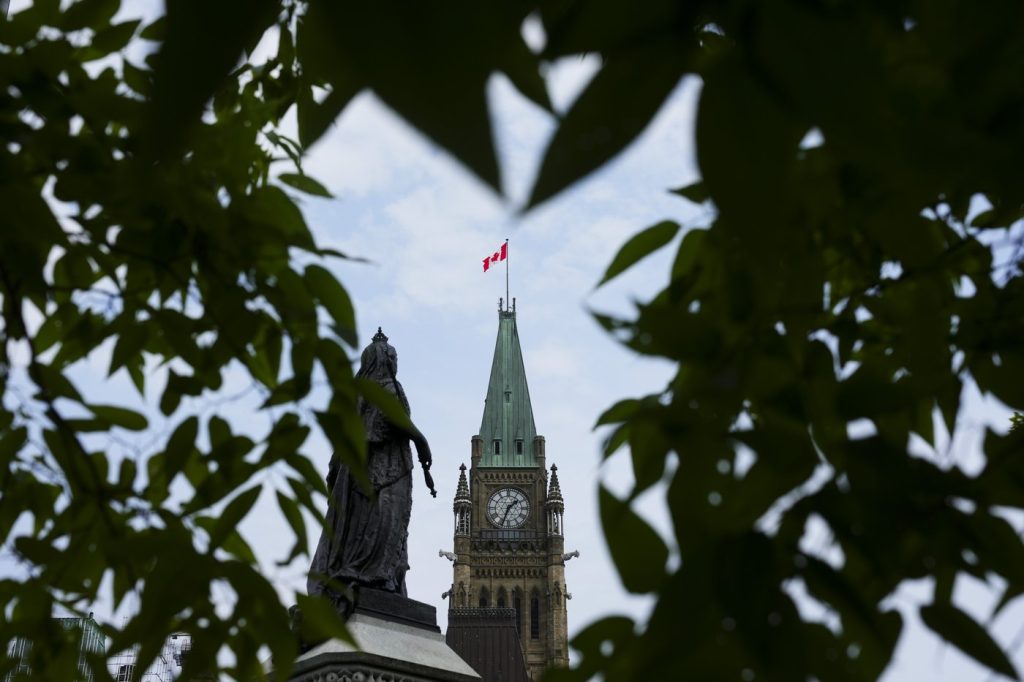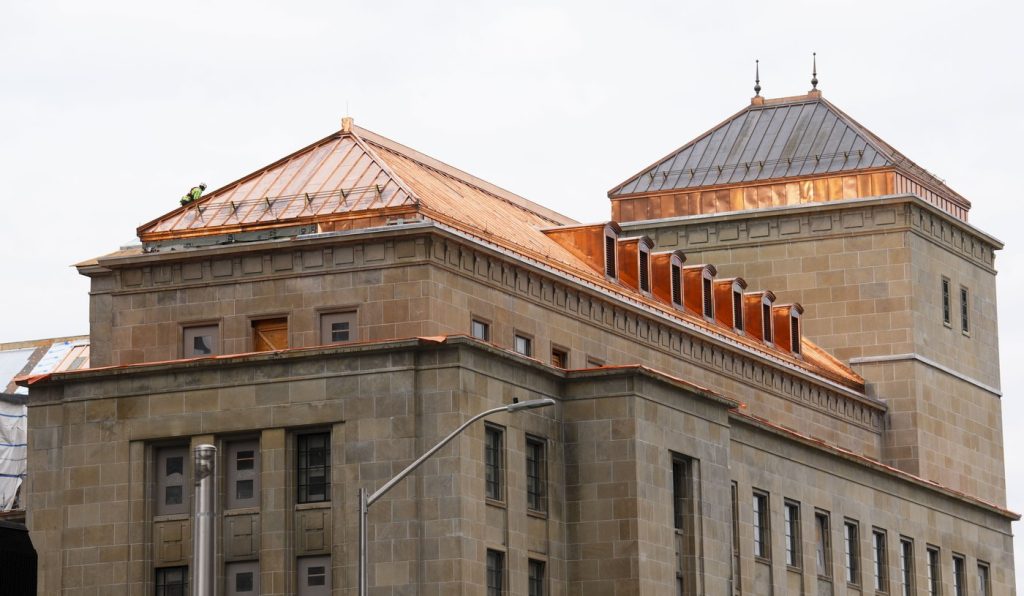Dr. Clement Ligoure: A Humanitarian Approach To Medical Care
Posted Feb 20, 2023 05:44:00 PM.
Last Updated Aug 1, 2023 09:16:11 AM.
Mahatma Ghandi once said: “The best way to find yourself is to lose yourself in the service of others.” His statement perfectly describes the unconditional selflessness of Dr. Clement Ligoure during the chaotic weeks following the 1917 explosion in Halifax Harbour.
Clement Courtenay Ligoure was born on 13 October 1887 on the Caribbean island of Trinidad to parents Clement François – a deputy marshal and accountant for the Supreme Court of Trinidad and Tobago – and Amanda M. (Crooke) Ligoure. He immigrated to The United States in April 1904 when he was 19 and took up residence in New York City. Five years later, he married Vivian E. Haynes a 22 year old woman from British Guiana, but their marriage was only short-lived.
As a single man, Ligoure relocated to KIngston, Ontario in Canada where he studied medicine at Queen’s University. He achieved his Bachelor of Medicine Degree (B.M.) in 1914 and his Doctor of Medicine Degree (M.D., C.M.) two years later. Luckily, he graduated before the university officially banned Black medical students in 1918. The reason: The university wanted to improve its reputation with the American Medical Association which rated the quality of medical schools in both the United States and Canada. This racist policy was in place until 1965, yet it took another forty-three years before the university formally repealed the ban in 2018.
While living in Kingston, Ligoure would occasionally return to Trinidad as well as to New York City. In September of 1915, while staying at 253 West 43rd Street, he worked at New York’s Harlem Hospital on 136th Street. Earlier, he had signed a Declaration of Intention to become an American citizen. Unlike Canada, the U.S. was not involved in World War One at this time, but after graduating from medical school, Dr. Ligoure decided to stay in Canada and enlist in the military, specifically, as a medical officer with the newly-formed No. 2 Construction Battalion.
At the beginning of WWI in 1914, many Canadian Black men were willing and eager to enlist in the armed services and do their part to aid in the country’s war effort. Approximately 1,300 men enlisted for service in the Canadian Expeditionary Force (CEF) including 300 draftees. Of these men, 200 were rejected and 100 went to fight on the front lines. Over 400 enlisted in other units of the CEF. The rest of the enlistees served in the soon to be formed No. 2 Construction Battalion. Although racism ran rampant within the military, Black community leaders across the country exerted pressure to allow for a segregated Black infantry battalion.
A promise to act was made by the Canadian minister of Militias and Defence, Samuel Hughes, but walked back soon after for various reasons, one being that the military did not want an armed Black unit that could potentially use their learned abilities in the field against British authorities in the colonies. A compromise allowing for the organization of an unarmed Black labour group for necessary support in the campaigns proved acceptable. This resulted in the formation of No. 2 Construction Battalion under the command of Lieutenant-Colonel Daniel Sutherland.

The following is the first point of a directive from Sir Willoughby Gwatkin, KCMG, CB Chief of the General Staff, written on 13 April 1916 regarding the No. 2 Construction Battalion:
“Nothing is to be gained by blinking facts. The civilized negro is vain and imitative; in Canada he is not being impelled to enlist by a high sense of duty; in the trenches he is not likely to make a good fighter; and the average white man will not associate with him on terms of equality. Not a single commanding officer in Military District No. 2 is willing to accept a coloured platoon as part of his battalion (H.Q. 297-1-29); and it would be humiliating to the coloured men themselves to serve in a battalion where they were not wanted.”
The No. 2 Construction Battalion was authorized on 5 July 1916 and formed in Nova Scotia – first based in Pictou then in Truro. Over the course of the war, over 600 men served in the unit. Dr. Ligoure travelled to Halifax with the expressed purpose of becoming their medical officer. Unfortunately, a one point “error” on his application exam prevented him from obtaining this position – a disqualification likely due to the British War Office ergo the Canadian Department of Militias and Defence refusing to see past the colour bar. The appointment went to Dr. Daniel Murray, a white physician from Tatamagouche. Despite this setback, Dr. Ligoure assisted with recruiting and managed to raise over $2,000 for the company.
Dr. Ligoure was the first Black physician to practice in Nova Scotia. Though denied medical privileges in the city’s hospitals, he still managed to set up his practice and eventually serve as medical officer for employees of the Canadian National Railway (CNR). He also became involved in co-founding a newsmagazine publishing venture with Wilfred and Miriam DeCosta, located in the Keith Building (later, the Green Lantern Building) on Barrington Street. The Atlantic Advocate was the only publication in Canada that primarily served the interests of the Black community. At first, Dr. Ligoure contributed as managing editor then as publisher, taking over from Mr. DeCosta who left to join the No. 2 Construction Battalion.
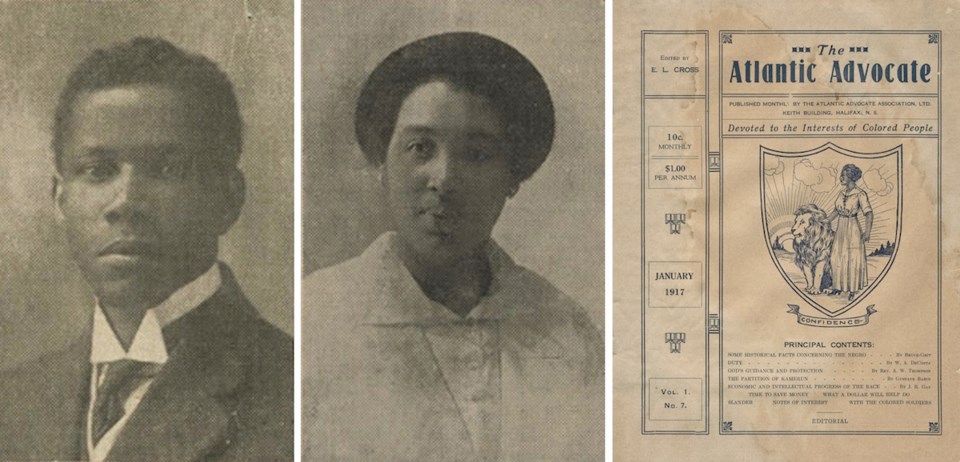
In 1917, Dr. Ligoure purchased a property at 166 North Street from a commission merchant, John W. DeWolf, for $3,600 (subject to terms), and relocated his practice along with the entire newsmagazine operation to this location. He named his fifteen-patient clinic, the Amanda Private Hospital, in honour of his mother.
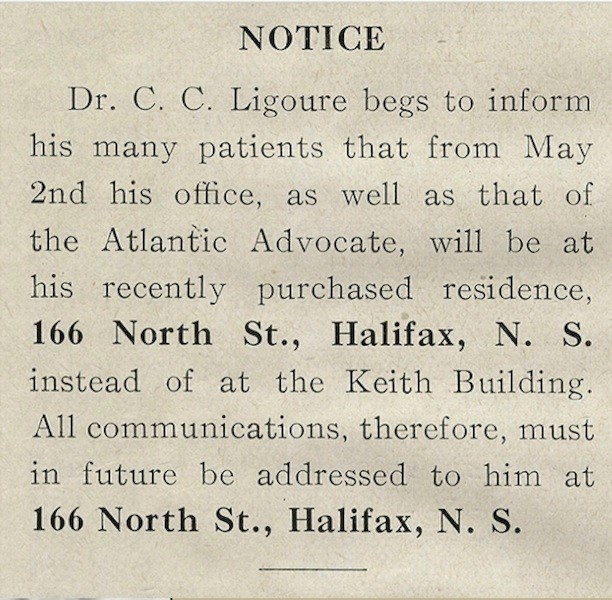
The numerous defining moments of Dr. Ligoure’s life were about to begin on the morning of Thursday, 6 December 1917. A French munition ship loaded with a cargo of volatile explosives and a sea-bound Norwegian freighter under charter from Belgian Relief collided near midstream. Approximately twenty minutes later, a catastrophic 2.9 kiloton explosion completely devastated the North End of Halifax, killing over 2,000 people, making thousands more homeless, and causing millions of dollars worth of property damage.
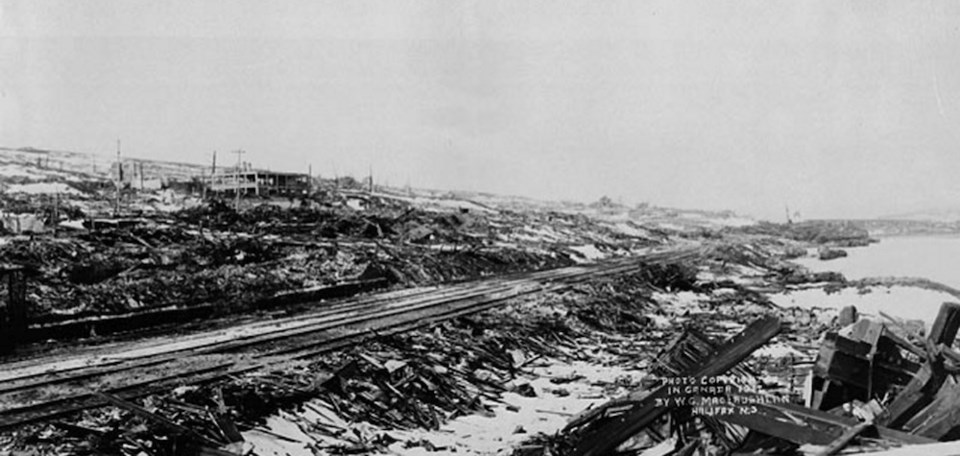
Almost immediately after the blast, injured patients inundated Dr. Ligoure’s office. He was the only physician who serviced the entire area around Willow Street and north to the now destroyed cotton factory on the corner of Kempt and Robie. With many cases coming through his door, some extremely serious, he pressed forward with only his housekeeper and a boarder (a CNR porter) to assist him. Despite being warned of a possible second explosion, he continued working non-stop for almost ten and a half hours. Scores of his new patients had been turned away from the hospitals. With nowhere else to go, they desperately sought out Dr. Ligoure. At the conclusion of the first day’s work, seven people stayed overnight in the hospital laid out on blankets.
The city endured a blizzard then driving rain throughout the next three days. Dr. Ligoure spent his daylight hours working in his hospital and nights doing outside calls, coming home completely exhausted. The following Monday, he went straight to City Hall to let it be known that a dressing station was needed in his district. Without hesitation, the person in charge of medical relief, Lieutenant Ryecroft, offered him the services of two nurses to alleviate the workload. And soon after, over a dozen more nurses and three men, including the assistant medical officer for Medical Relief, Captain Dr. Parker, were assigned to the North Street hospital – now designated No. 4 Dressing Station. Dr Ligoure’s team kept up with their grueling schedule until 28 December.
From 6 December onward, Dr. Ligoure had not charged a single penny for his services. Afterwards, he worked gratis for Medical Relief but was at least given the use of a car to travel to and from his patients. Near the end of January 1918, he still treated over 50 people a day, many arriving at his office with explosion-related injuries. Dr. Ligoure continued his practice throughout the year and into the next.
By 1919, the Nova Scotia temperance laws had been enacted and the police were cracking down on various alcohol-related offenses. On 17 January, the town was all astir over an article that appeared in the Halifax Herald newspaper stating that Dr. Ligoure, after being served a warrant, had been brought to the police station and arraigned for having sold a bottle of alcohol for two dollars to an unnamed Frenchman. Dr. Ligoure pleaded not guilty. The Frenchman happened to be in court at the same time charged with drunkenness. Apparently, he mixed the alcohol with some ”invalid port wine” and became overly intoxicated.
It is folly to suggest or assume that the good doctor would have meant for the man to ingest the alcohol orally. A more plausible scenario is that the Frenchman was one of Dr. Ligoure’s transient patients who decided on his own to mix the alcohol with his port wine and ended up giving himself a near case of alcohol poisoning. Instead of accepting responsibility for his actions, he blamed Dr. Ligoure for selling the bottle of alcohol to him in the first place. In fact, the Halifax Herald article clearly states that the case focussed on the notion of whether a physician should be permitted to sell alcohol to his patients under the present temperance laws. The worst result may have been that Dr. Ligoure paid a fine up to the amount of $200 (approximately half of the average working man’s yearly wage) or at best, he would have been acquitted.*
Dr. Ligoure put aside some time to visit his parents at 33 Abercrombie Street in Port of Spain, Trinidad. Upon his return to Halifax, he began to suffer a severe and protracted illness. In due course, his affliction forced him to seek relief in a warmer climate. It is a matter of record that in 1921 at age 35, he returned his North Street house to John DeWolf’s widow, Mary R. DeWolf on 21 February as per Release of Agreement, for the price of $1.00. Three days later, the property was turned over to Mr. And Mrs. Garnet A. Little. Where Dr. Ligoure continued to reside and practice after leaving his house is uncertain. His name and the Amanda Private Hospital are absent from the 1921-22 McAlpine’s Halifax City Directory.
At the beginning of May 1922, Dr. Ligoure decided to take a short holiday and stay with his brother Clarence, a solicitor living on the island of Tobago, northeast of Trinidad – ostensibly, with every intention of returning to Halifax. However, the trip which he thought would help mitigate his condition only served to worsen it. He soon contracted malignant malaria and became deathly ill. On Friday, 19 May 1922, Dr. Ligoure was transported to Port of Spain, taken to the Colonial Hospital and immediately placed under the care of Drs. Campariole, Payne and Bass. He was dutifully looked after by the nursing sisters there and Nurse Austin. As well, he received the affectionate attention of another brother, Lucien, recently returned from New York. All resources at the hospital were directed towards treating Dr. Ligoure’s ailment.
Unfortunately, his health deteriorated despite all efforts to save him. Clement Ligoure died on the afternoon of Tuesday, the 23rd of May at the hospital. His funeral took place on the following day at 5 p.m. from his parents’ Abercromby Street home to the Church of the Sacred Heart where Reverend Father Lamarre, O.P., officiated at the service. Members of Ligoure’s family and his many friends attended. No mention of his death has been found in any concurrent Halifax news publication.
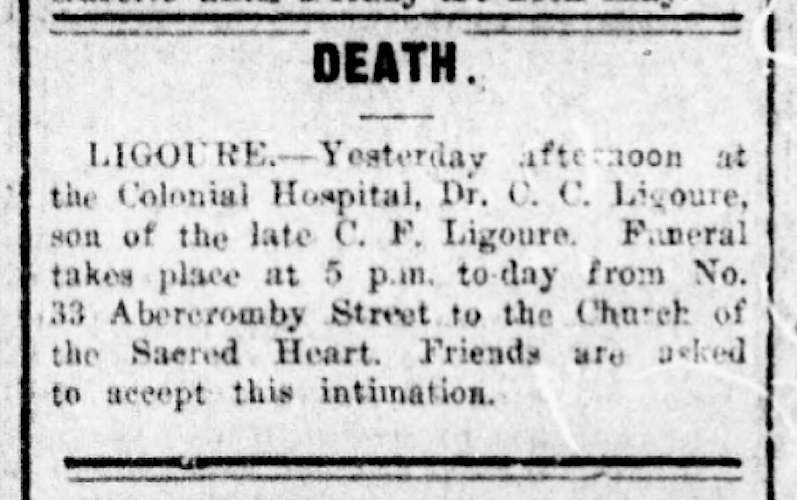
Recently, Dr. Ligoure’s former home, what remains of a once a much larger structure, became the subject of a concerted local campaign to pressure City Council to register the house (listed as 5812-14 North Street) as a municipal heritage property under the Heritage Property Act. The property is currently owned by a developer who asserted there was no intention of having the house demolished and that it sits outside the area of Robie Street slated to be widened. Notwithstanding these assurances, the group Friends of Halifax Common and several prominent leaders of the Black community sought to preserve this historically and architecturally significant building as an important social landmark for future generations – and most importantly, to recognize Dr. Ligoure’s work and Black Heritage in HRM.
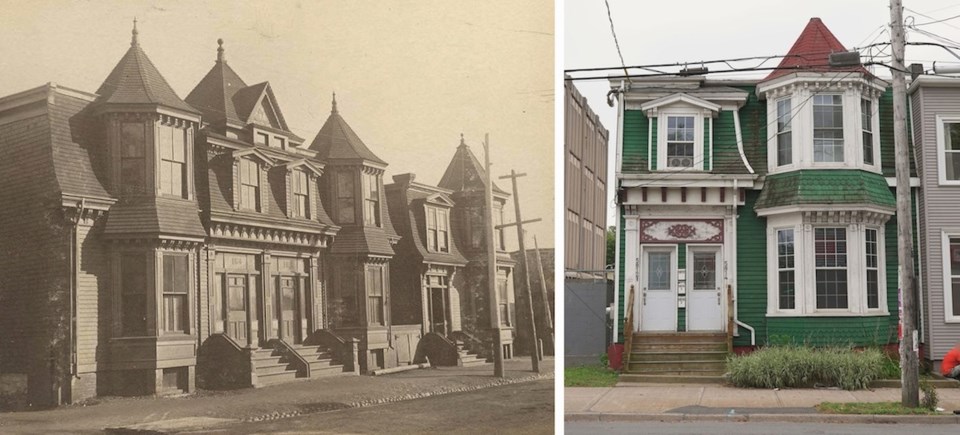
The successful action to save the house caused a wide resurgence of interest in the life story of this inspirational man. I am hopeful that researchers will seize upon the opportunity to expound upon the new particulars presented in this article. By all accounts, descendants of Dr. Ligoure and those of his friends are also living in Trinidad and Tobago as well as in the United States. They may provide additional family history and much needed archival photographs.
A more comprehensive, contextual account of Dr. Clement Courtenay Ligoure’s life is required to forever ensure his vital legacy will be remembered by our entire community.
Sources: Port of Spain Gazette, Wednesday, 24 May 1922, p. 4, and Tuesday, 30 May 1922, p. 4; “Dr. Ligoure’s Hospital at 166 North Street, Halifax,” by Garry Shutlak, The Griffin, March 2020, pp. 7 & 19; Dr. C.C. Ligoure’s personal narrative as told to Archibald MacMechan in January 1918, N. S. Archives, MG1 vol. 2124, nos. 166 and 166a; Queen’s University; HRM Council / Heritage Advisory Committee meeting records, Items 18.8.2 & 12.1 (William G. Petrites); McAlpine’s Halifax City Directories; University Affairs online; The Canadian Encyclopedia and Valour Canada (Lindsay Ruck and Mathias Joost); David Woods; various online genealogy and news resources.
Notes: It is indicated that Dr. Ligoure had a third brother named Charles Austin Raymond Ligoure (1885-1935) who immigrated to the United States and enlisted in the U.S. Army in August 1918 and was discharged in December. His occupation thereafter was listed as a professional “Waiter – Hotel.” Source: Alabama Deaths, 1908-1974.
The following is a list of mourners present at Dr. Clement Ligoure’s funeral (Port of Spain Gazette, 30 May 1922):
Bearers: Messrs. J. Ligoure, Drs. Lermont, Lynch and Gittens, and R.M.T. Pritzgar and E. McEachran.
Followed by: Drs. H. Lynch and Harley, Paul McCarthy, Sydney Smith, E. Mitchell, J. Chandler, E. Thomas, A. Burns, Chs. Rene and Bonterre (likely Dr. Ligoure’s third brother and his wife), Mr. and Miss Gordon, Miss Wilson, Miss Sanchez, Miss Branker, Miss Facey, Mrs. Pitman, Mrs. Monteil, Miss H. A. Wharton, Mrs. and Miss Harrison, Miss Myra Monsegue, Miss Hart, Miss Durham, Mrs. J. Alvarez, Miss Sasportas, Misses Faure, Miss Hatt, Mr. and Mrs. Camps, Miss Donaldson, Miss G. Marquez, Miss F. Cabrera, Miss O’Brien, Miss A. Ayers, Miss Smith, Misses Donawa, Mrs. Lucien, Mrs. E. Thomas, Mrs. St. Clair Goodridge, Misses Melita Goodridge and Gladys Goodridge, Miss D. Euchrane, Misses Subero (2), Mrs. Rawle and Misses Austin.
Floral tributes sent by: Mrs. Penco and family, Mr. Fedna Ligoure, the Misses Ligoure, Mr. and Mrs. Clarence Ligoure and family, Mr. Lucien Ligoure, Mr. Charles Ligoure, Mr. and Mrs. Alvarez, Mr. and Mrs. St. Clair Goodridge and family, Mr. and Mrs H. A. Wharton, Mr. and Mrs. E. Thomas and Mrs. Lucien.
*An article about this case also appeared in the 17 January 1919 edition of the Saint John Standard, p. 4. I followed up with research of subsequent editions of the 17 January article in the Halifax Herald up to and including 25 January 1919, but could find nothing concerning the resolution of this matter. I am therefore left to surmise that the case was resolved in favor of Dr. Ligoure. Follow this link to the original article: http://www.halifaxexplosion.net/charges.jpg.
